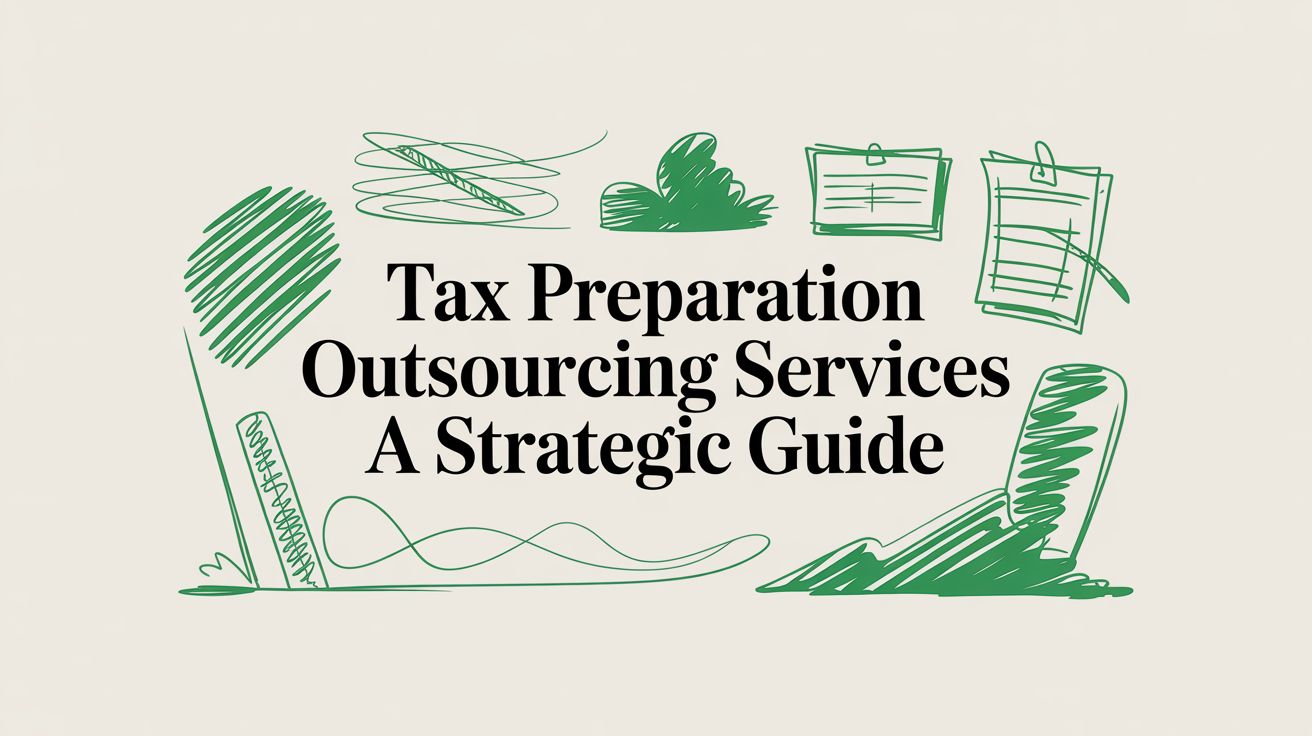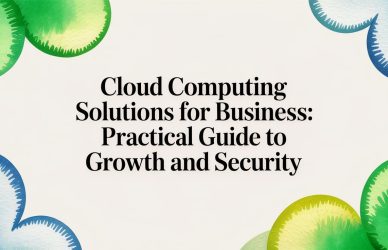Imagine a tax season where your team isn’t just surviving, but thriving. Instead of being buried under a mountain of compliance work, they’re focused on high-value client advisory. This is the reality that tax preparation outsourcing services can create, shifting your firm from a reactive, deadline-driven machine to a proactive, growth-oriented partner for your clients.
Moving Beyond Busy Season With Tax Outsourcing

The smartest firms I’ve worked with know that a good outsourcing partnership is about so much more than cutting costs. When you offload the repetitive, time-sucking tasks of tax preparation, your core staff finally has the bandwidth to apply their expertise where it really counts: deepening client relationships and building out new advisory services.
This isn’t just a hypothetical nice-to-have; it’s a solid business strategy. The global accounting outsourcing market, which includes these tax services, is projected to grow at a CAGR of 9.1% from 2023 to 2030. That growth is happening for a reason. Firms are seeing tangible results, with some slashing operational costs by up to 50% by shedding expenses tied to salaries, benefits, and constant training. You can find out why smart accounting firms are switching to tax preparation outsourcing in 2025 and get ahead of the curve.
The Advantage of a US-Based Partner
While you can technically outsource anywhere, I’ve seen firsthand how partnering with a US-based service provider delivers distinct, immediate advantages. It’s a move that protects your firm and elevates your service quality. This isn’t just about geography; it’s about being on the same page in every critical area of your business.
A US-based partner operates as a true extension of your team, not just a vendor. They understand the nuances of the American business landscape, speak the same professional language, and are accountable under the same legal and regulatory frameworks you are.
Choosing a partner in the United States means you get seamless collaboration. You’re working in similar time zones. Those frustrating delays waiting for an overnight response from a team halfway around the world? Gone. When a complex tax issue pops up, your outsourced team is there for a real-time call, enabling the agile, on-the-fly problem-solving that tax season always demands.
Aligning on Compliance and Culture
Perhaps the most compelling benefit is the shared, ingrained understanding of our labyrinthine federal and state tax codes. A US-based team doesn’t need a crash course on IRS regulations or the quirky filing requirements of different states. That built-in expertise minimizes the risk of compliance errors right out of the gate and ensures a higher quality of work.
This professional and cultural alignment is what really sets the stage for a more profitable, sustainable practice. The key benefits of using a partner from the USA are clear:
- Effortless Communication: Real-time collaboration without fighting timezone differences.
- Deep Jurisdictional Knowledge: Genuine expertise in both federal and state-specific tax laws.
- Shared Business Ethics: A common ground on professional standards and what great client service looks like.
- Simplified Legal Recourse: Operating under the same legal system gives you straightforward protection and peace of mind.
By bringing on tax preparation outsourcing services with a domestic partner, you aren’t just offloading work. You’re investing in a more resilient, client-focused, and scalable future for your firm. It’s how you turn tax season from a period of sheer survival into an engine for strategic growth.
The Real Benefits of Outsourcing Tax Preparation

The advantages of using tax preparation outsourcing services go so much deeper than just the numbers on a balance sheet. Yes, cost reduction is a big driver, but the real value is in building a more resilient operation and unlocking new strategic doors for your firm. It’s about fundamentally changing how you survive—and thrive—during your busiest seasons.
Think about a real-world scenario I’ve seen play out many times: a mid-sized CPA firm is deep in a client’s complex merger. The deal finally closes late in Q4, creating an absolute avalanche of intricate tax filings due in just a few months. Without a partner, that firm is looking at a frantic, last-minute hiring scramble for temporary staff, which stretches resources thin and risks burning out their best people.
But with a trusted outsourcing partner in their corner, the firm can scale its capacity almost instantly. They get immediate access to a team of seasoned pros ready to tackle the high-volume work, freeing up the in-house experts to focus on the high-level strategic headaches of the merger. This is about creating a more agile and adaptable business model for the future, a benefit amplified when your partner is in the USA and can collaborate in real-time.
Gaining Specialized Expertise on Demand
One of the most powerful—and often overlooked—benefits is getting access to specialized knowledge exactly when you need it. Your firm might be full of general tax rockstars, but what happens when you land a client in a niche industry like renewable energy or international e-commerce? Instead of turning that business away or scrambling to get up to speed on complex regulations, you can simply tap into your outsourcing partner’s specialists.
This on-demand expertise completely transforms your firm’s capabilities. It allows you to confidently pursue clients you previously couldn’t serve, effectively broadening your service offerings without the massive financial commitment of hiring full-time specialists for every possible tax scenario. The true value here is particularly clear for busy professionals, as it helps accountants optimize operations and smooth out the brutal peaks and valleys of seasonal demand.
The Strategic Edge of a US-Based Partnership
Choosing where you outsource is just as critical as the decision to do it in the first place. Offshore options might dangle a lower price tag, but a US-based partner provides a strategic advantage that pays dividends in security, reliability, and sheer peace of mind.
A partnership with a US-based firm is an investment in alignment. It ensures your outsourced team operates under the same legal protections, business ethics, and data security standards that your own clients demand from you.
This domestic alignment delivers several huge operational wins:
- Superior Data Security: A US-based provider that maintains SOC 2 compliance isn’t just making promises; they’re offering a verifiable guarantee of their security controls. This is non-negotiable when you’re handling sensitive client financial data.
- Straightforward Legal Recourse: If any issues come up, you’re operating under a familiar US legal framework. This simplifies contracts and gives you clear, enforceable protections that can get murky fast with international providers.
- Cultural and Regulatory Fluency: Your US-based partner just gets it. They inherently understand the nuances of IRS procedures and the labyrinth of state tax laws, which drastically reduces the risk of expensive compliance mistakes.
This is about building a secure and efficient extension of your own team. While the immediate cost savings are nice, the long-term value comes from this enhanced operational integrity.
Let’s look at how this plays out in practice.
In-House vs US-Based Outsourcing A Comparison
This table breaks down the key differences between keeping all tax preparation in-house and partnering with a specialized US-based provider. It highlights the trade-offs in everything from cost and expertise to security and scalability.
| Factor | In-House Team | US-Based Outsourcing Partner |
|---|---|---|
| Cost Structure | High fixed costs: salaries, benefits, overhead | Variable costs: pay only for services used |
| Scalability | Limited; slow to scale up or down for seasons | High; instantly access more capacity on demand |
| Expertise | Limited to your full-time staff’s knowledge | Access to a broad pool of niche specialists |
| Recruitment | Time-consuming and costly hiring processes | No recruitment burden; partner handles all staffing |
| Data Security | Security burden falls entirely on the firm | Shared responsibility with a SOC 2 compliant expert |
| Focus | Core team often buried in compliance tasks | Core team can focus on high-value client advisory |
Ultimately, the choice depends on your firm’s strategic goals. An in-house team offers direct control, but a US-based partner provides unparalleled flexibility and access to specialized talent without the fixed overhead.
Tangible Wins and Future Growth
The numbers don’t lie. Outsourcing can slash workforce-related expenses by 20% to 60% on finance operations. Right now, about 25% of U.S. CPA firms outsource at least some of their work, and a telling 65% of those firms plan to expand their outsourcing activities. That’s a powerful signal that this model works.
Engaging with domestic tax preparation outsourcing services isn’t just about offloading work. It’s a strategic move to build a more robust, scalable, and competitive firm. You cut overhead, of course, but more importantly, you create the bandwidth for your best people to do what they do best: delivering high-value advisory services and growing your business.
How to Choose the Right Outsourcing Partner

Let’s be honest: picking the right partner for tax preparation outsourcing services is where everything can go right—or terribly wrong. This is the single most important decision you’ll make. You’re not just hiring a vendor; you’re bringing on an extension of your team that will handle your clients’ most sensitive data.
Get this wrong, and you’re looking at compliance nightmares, security breaches, and unhappy clients. But get it right, and you can genuinely transform your firm’s capacity and profitability. It all boils down to a serious, structured vetting process. You need a playbook that goes beyond the sales pitch to really understand what a potential partner is made of, especially when selecting a partner within the USA.
Evaluating Technical Proficiency and Tools
First things first, you have to know if they can plug into your existing systems without causing chaos. If their process creates friction with your workflow, you’ve already lost the efficiency you were hoping to gain. Get specific about their tech stack.
Don’t settle for a simple “yes, we use that software.” You need to dig deeper. Ask them to prove their experience and skill with the platforms your firm lives and breathes every day, such as:
- Drake Software
- UltraTax CS
- Lacerte
- ProSeries
- CCH Axcess
Fluency in your core software is absolutely non-negotiable. A partner who stumbles with your tools isn’t a partner; they’re a liability. This is a foundational step in any https://ninearchs.com/skills-outsourcing/business-process-outsourcing/ relationship.
Scrutinizing Security and Compliance Protocols
When you hand over tax documents, you’re handing over the keys to your clients’ financial lives. That means your partner’s security and compliance framework has to be bulletproof. A casual “we take security seriously” just doesn’t cut it. You need to see proof.
Your client data is your firm’s most valuable asset. The security standards of your outsourcing partner must meet or exceed your own. There is no room for compromise.
Ask to see their formal data security policy. This document should spell out everything from data encryption methods to access controls. What about their disaster recovery plan? What happens if their systems crash in the middle of March? A professional outfit will have a clear, documented answer ready to go.
It’s also smart to evaluate their approach to third-party risk management to see how they vet their own vendors. And don’t forget to ask about their people. Do they run thorough background checks on their staff? This tells you a lot about how deeply security is embedded in their company culture.
The Due Diligence Checklist for a US-Based Partner
Working with a US-based partner offers a home-field advantage when it comes to compliance, but you still need to do your homework. They operate under the same regulatory umbrella, which makes verification and accountability much more direct. Here’s what you need to lock down:
- Errors & Omissions (E&O) Insurance: This is non-negotiable. Ask for their certificate of insurance. Any reputable US firm will carry significant coverage and won’t hesitate to show you their documentation. It’s your safety net.
- Local and State-Specific References: Don’t just ask for any reference; ask for firms in your state or region. Talking to them will give you priceless insight into how well the partner handles nuanced state filing requirements—a common weak spot for offshore providers.
- Professional Credentials: Who is actually doing the work? Verify that their team includes Certified Public Accountants (CPAs), Enrolled Agents (EAs), or other credentialed professionals who are up-to-date on US tax law and IRS regulations.
- Regulatory Compliance: Confirm they know and follow all IRS guidelines for data security and handling for paid preparers. A US-based team should have an inherent, deep understanding of these rules.
This isn’t just a checklist; it’s about building confidence. By thoroughly vetting a provider’s technical skills, security posture, and professional credentials, you’re ensuring you choose a firm that will act as a true, accountable extension of your team. This is how you build a partnership that lasts.
Integrating Your Partner for a Seamless Workflow

You’ve gone through the exhaustive process of vetting and selecting a provider. Now the real work begins. A successful partnership with a tax preparation outsourcing services firm doesn’t just happen; it’s built on a thoughtful and deliberate integration into your existing operations. This is about more than just lobbing files over a digital wall. It’s about creating a connected, secure, and efficient workflow that makes your outsourced team a true extension of your own.
A clunky integration will wipe out any potential gains before you even get started. The goal is to make the entire process so smooth that it’s invisible to clients and a force multiplier for your internal staff. That all starts with a structured, milestone-driven plan.
Kicking Off the Onboarding Process
The initial kickoff meeting is your best opportunity to get everyone on the same page from day one. This isn’t just a quick “hello.” It’s a strategic session where you and your new partner align on the nitty-gritty details of how work will actually get done.
This is where you’ll define the exact protocols for transferring sensitive client data, almost always through a secure, encrypted portal. You’ll also map out communication channels. Who’s the primary contact for daily questions? What’s the escalation path if something urgent comes up? Nailing this down immediately prevents a lot of headaches and bottlenecks once tax season hits. It’s also a good idea to set up a shared channel in Slack or a board in a project management tool to keep all communication in one place.
Building the Technical and Operational Framework
Once communication lines are clear, the next step is granting the necessary system access. Your partner will need to get into your tax software and document management systems, and this is where you need to be careful. Work with your IT team to grant access based on the principle of least privilege—they get access only to what they absolutely need.
A typical onboarding timeline might look something like this:
- Week 1: Kickoff & Discovery. This is for formal intros, deep-diving into your specific workflows, and finalizing the communication plan.
- Week 2: System Access & Training. Time to provision secure software access and give the outsourced team an orientation on your firm’s unique processes and standards.
- Weeks 3-4: The Pilot Batch. Run a small, curated batch of 5-10 non-critical returns. This tests the entire workflow, from data transfer to your final review.
The pilot phase is non-negotiable. Think of it as a low-risk stress test that exposes any friction points in your process before you’re buried in high-stakes work. This is your chance to iron out the kinks.
This phased approach builds confidence on both sides and lets you course-correct early. After a successful pilot, you can start scaling up the volume, knowing you have a proven, reliable process in place.
The Advantage of Real-Time US-Based Collaboration
Here’s where choosing a US-based partner really pays off. Overlapping work hours aren’t just a nice-to-have; they’re a massive strategic advantage. When your internal reviewer has a question about a tricky K-1 or a specific deduction, they can get an answer in minutes, not the next business day. That ability to collaborate in real-time is what keeps work moving and helps you hit those tight deadlines.
This dynamic also makes training much simpler. Your team can guide the outsourced staff through your firm’s unique review and approval cycles with direct, immediate feedback. This helps your new partner get up to speed on your quality standards incredibly fast. Augmenting a core team with specialized help is a powerful strategy, and you can learn more by exploring the benefits of outsourced virtual assistants.
Let’s be honest—the accounting profession is facing a serious talent shortage. With the U.S. accounting field projected to grow at an 11% annual rate through 2026, the competition for skilled professionals is only getting more intense. You can discover more insights about the state of the tax profession to see just how these trends are shaping the industry. By integrating a reliable partner now, you’re not just solving a capacity issue; you’re building a more resilient and scalable operational model for the future.
Measuring the Success of Your Partnership
Once your new partner is onboarded and integrated, the real work begins. The focus shifts from setup to performance, and it’s about more than just checking a box. To truly understand the return on your investment in tax preparation outsourcing services, you have to look beyond simple cost savings.
Real success is measured in gains across the board—in quality, efficiency, and the strategic value you’re bringing back into your firm. This means you need to establish and track the right Key Performance Indicators (KPIs) right from the start. Without them, you’re just guessing.
Defining What Success Looks Like
A data-driven approach is the only way to manage your outsourcing partner effectively. It’s how you’ll prove the partnership’s value to stakeholders and build a relationship grounded in accountability and a desire to improve.
The best KPIs are always tied directly to the goals you set out to achieve in the first place. While every firm’s needs are a bit different, a solid performance dashboard should always focus on three core areas: quality, efficiency, and strategic impact. Tracking these gives you the full story of how the partnership is really performing.
If you only track cost, for example, you might be celebrating a low per-return price while completely missing a high error rate that’s secretly costing your in-house team dozens of hours in rework. A balanced set of KPIs prevents these kinds of blind spots.
Think about a metric like First-Pass Accuracy Rate. A high number here is a powerful signal. It tells you the work coming back from your partner is clean, compliant, and needs very little, if any, intervention from your internal reviewers. That directly translates into more time for your senior staff to focus on what they do best.
Establishing clear, mutually agreed-upon KPIs is the foundation of a healthy outsourcing relationship. It transforms the dynamic from a simple vendor transaction into a strategic partnership where both parties are aligned on the definition of success.
Key Performance Indicators That Actually Matter
When you’re getting started, don’t try to track everything. That’s a recipe for analysis paralysis. Instead, zero in on a handful of high-impact metrics that give you genuinely actionable insights.
Here are a few essential KPIs to build your performance dashboard around:
- First-Pass Accuracy Rate: What percentage of returns get a green light from your internal review team without needing any corrections? A high rate, ideally 98% or better, is a direct reflection of your partner’s quality control and attention to detail.
- Turnaround Time (TAT) by Return Complexity: Don’t settle for a single, average TAT. You need to segment it by the type of return (e.g., a simple 1040 versus a complex 1120-S). This gives you a much more nuanced picture of their efficiency and helps you spot bottlenecks before they become major problems.
- Billable Hours Reclaimed: This is where the strategic value really shines through. Track the hours your senior staff would have spent on compliance work but are now free to dedicate to high-value client advisory services. This KPI directly demonstrates the strategic ROI of the partnership.
Why a US-Based Partner Simplifies Performance Management
When it comes to tracking these metrics, having a US-based partner offers a clear advantage in both communication and accountability. If a KPI like Turnaround Time starts to slip, you can pick up the phone and have a real-time conversation during your own business hours to figure out what’s going on. That immediate feedback loop is absolutely critical for making quick course corrections, especially during the chaos of tax season.
Beyond logistics, a domestic partner operates under the same professional standards and cultural work ethics you do. This makes conversations about quality and accuracy much more straightforward. There’s a shared understanding of what “good work” actually looks like, which simplifies performance management and helps build a sense of a truly unified team.
To help you get started, we’ve outlined a simple but powerful table of essential KPIs.
Essential KPIs for Tax Outsourcing Success
This table summarizes key metrics to track the performance and ROI of your tax preparation outsourcing partner, ensuring accountability and continuous improvement.
| KPI Category | Metric to Track | Success Benchmark |
|---|---|---|
| Quality | First-Pass Accuracy Rate | >98% |
| Efficiency | Turnaround Time (Simple 1040) | <24 Hours |
| Efficiency | Turnaround Time (Complex 1120) | <48 Hours |
| Strategic Value | Billable Hours Reclaimed by In-House Team | 10+ hours/week per senior staff member |
| Client Impact | Reduction in Client Queries Post-Filing | <5% |
By consistently keeping an eye on these KPIs, you create a transparent and performance-focused partnership. This data-driven approach doesn’t just ensure you’re getting the value you paid for—it builds a strong foundation for a long-term collaboration that can grow with your firm.
Common Questions About Tax Outsourcing
Making a big operational shift like outsourcing your tax preparation naturally brings up a lot of questions. This isn’t just about hiring a vendor; you’re fundamentally changing your firm’s workflow and entrusting a partner with sensitive client data. It’s smart to have concerns.
Let’s walk through the most common questions firm leaders ask when they’re on the fence. Getting clear, practical answers is the last step before you can move forward with confidence.
How Can I Guarantee Client Data Is Secure?
This is, without a doubt, the most critical question—and it should be. When you’re dealing with your clients’ most sensitive financial information, a simple “we take security seriously” just doesn’t cut it.
The real answer lies in demanding proof. For any partner, especially one based in the US, a SOC 2 Type II report is the gold standard and should be non-negotiable. This isn’t just a one-time check; it’s a rigorous audit of their security controls over a long period, proving their systems are genuinely secure.
Beyond that, dig into the details. Make sure they use end-to-end encryption for all data, both when it’s being sent and when it’s stored. Don’t hesitate to ask tough questions about their access controls, employee background checks, and even the physical security of their offices. A trustworthy partner will have these answers ready and will happily sign a comprehensive NDA that clearly outlines their responsibilities.
What Do These Services Typically Cost?
Understanding the pricing structure is key to making sure this move makes financial sense. Most providers operate on one of three models, and the best fit really depends on your firm’s specific needs and volume.
- Per-Return Model: This is straightforward. You pay a fixed fee based on the complexity of the return (a simple 1040 is cheaper than a multi-state 1120-S). It’s perfect for firms with unpredictable or seasonal workflows.
- Hourly Rate Model: This works best for less defined projects, like complex advisory work or forensic accounting, where a fixed fee isn’t practical.
- Dedicated Resource Model: If you have a high volume of work, this is often the most cost-effective option. You pay a flat monthly fee for a dedicated professional (or team) who functions as an extension of your own staff.
No matter the model, insist on a detailed service-level agreement (SLA). This is your protection against scope creep and surprise fees. It should spell out exactly what’s included, what’s not, and the expected turnaround times. This is another area where a US-based partner can be beneficial, as negotiating and enforcing SLAs is more straightforward under a shared legal framework.
Will Outsourcing Hurt My Client Relationships?
It’s a valid fear, but when done right, the opposite happens—outsourcing actually strengthens client relationships.
The trick is to remember what you’re outsourcing: the back-office compliance work, not the relationship itself. By handing off the grind of data entry and form preparation, your senior team is freed up to focus on what clients truly value: strategic tax planning, proactive advice, and personal attention.
The best outsourcing partnerships are completely invisible to your clients. All they see is that they’re getting faster, more strategic service from the trusted advisor they’ve always known—you.
To make this a reality, you must maintain a strict internal review process. The final work product should always have your firm’s stamp of approval on it before it ever reaches the client. You’re simply delegating the engine room tasks so you can spend more time on the bridge, steering the ship.
Why Should I Choose a US-Based Partner Over an Offshore One?
While offshore partners can seem cheaper on paper, the practical advantages of a US-based partner often deliver a much higher return on investment. The main benefits boil down to communication, compliance expertise, and legal alignment.
A domestic partner operates in your time zone. When a critical issue pops up mid-tax season, you can get someone on the phone immediately—a lifesaver when deadlines are tight. They also have a deep, intuitive understanding of the nuances of federal, state, and local tax codes, which dramatically reduces the risk of costly errors.
Most importantly, a US-based provider is governed by the same data privacy laws and legal system as your firm. If something goes wrong, you have clear and accessible legal recourse. That peace of mind is often worth the difference in price alone.
Ready to transform your tax season from a chaotic scramble into a strategic advantage? NineArchs LLC provides U.S.-based tax preparation outsourcing services designed to help you scale efficiently, reduce overhead, and free up your team for high-value advisory work. Explore our scalable solutions today.









